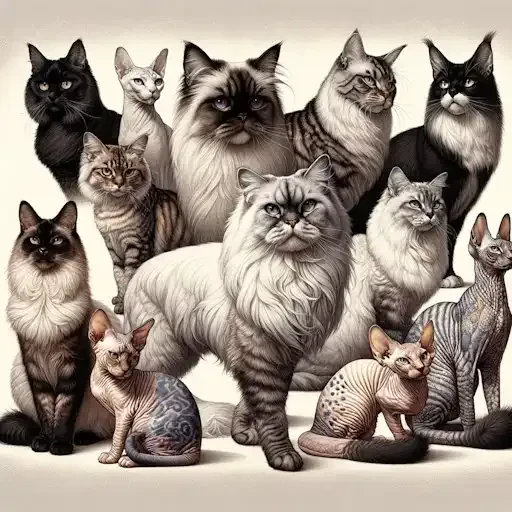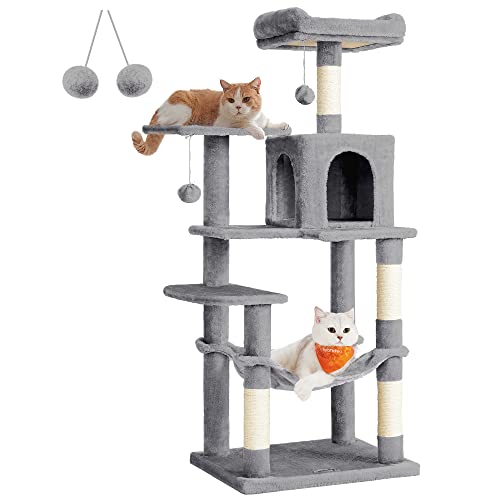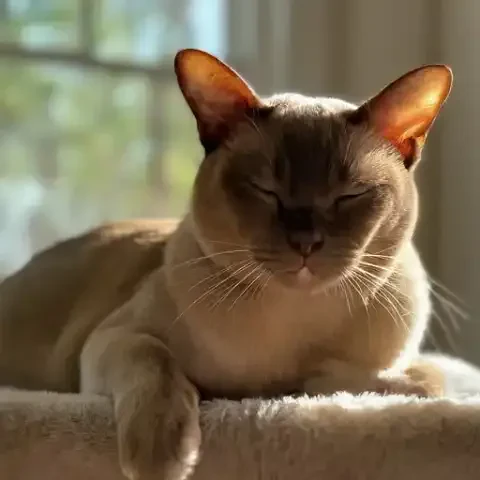Ever heard the saying, "a cat is a cat"? While charming in its simplicity, it overlooks the fascinating diversity that exists within the feline world. It’s easy to fall into the trap of thinking all cats are fundamentally the same, furry little enigmas purring on our laps or stalking dust bunnies under the furniture. But beneath the surface of shared feline behaviors, a spectrum of personalities unfolds, hinted at, and sometimes even defined by, breed. While the notion that breed dictates destiny is a vast oversimplification, dismissing breed predispositions entirely is to ignore a rich tapestry of feline traits that have been observed and documented for generations.
To suggest that all cats are born with identical personalities would be akin to saying all humans are the same – a notion quickly dispelled by anyone who has spent even a few moments observing the sheer variety of human behavior. Similarly, while each cat is undoubtedly an individual, shaped by their unique experiences and upbringing, certain temperamental threads do tend to run through specific breeds, whispers of inherited tendencies passed down through generations. This isn't about locking cats into rigid stereotypes or making sweeping generalizations. It's about acknowledging that just as dog breeds exhibit propensities for certain temperaments, so too do our feline companions. Understanding these tendencies can offer a fascinating glimpse into the world of feline personalities, and while never eclipsing the importance of individual variation, it can enrich our appreciation for the incredible diversity within the cat kingdom. This article will delve into the captivating world of feline personalities, exploring the unique traits often associated with different cat breeds, while emphasizing the crucial role of individual variation and the complex dance between nature and nurture.
Before we embark on exploring the fascinating world of breed-specific traits, it’s crucial to lay the groundwork with some important caveats. Understanding feline personality is not as simple as reading a breed description and expecting a perfectly predictable pet. The most fundamental point to grasp is the delicate interplay between genetics and environment, often referred to as the nature versus nurture debate. Breed predispositions, those inherited tendencies we’ll be discussing, are merely starting points, not predetermined destinies etched in feline DNA. A cat might be born with a genetic inclination towards a certain temperament, but their early socialization experiences, their upbringing within your home, and their individual life events will all play a profound role in shaping the final feline personality that emerges. Think of it like a seed: genetics provide the potential, but the soil, water, and sunlight of their environment determine how that seed will grow and flourish.
Furthermore, even within breeds known for exhibiting particular traits, individual variation remains the golden rule. To suggest that all Ragdolls are docile lap cats or all Siamese are relentlessly vocal is a harmful oversimplification. Just as human siblings from the same parents can have wildly different personalities, so too can littermates within a specific cat breed. Avoid the trap of thinking of any breed as a monolith of personality, a homogenous block of predictable behaviors. Instead, approach breed descriptions with a discerning eye, understanding them as descriptions of tendencies, of traits that are often described within a breed, or behaviors a cat may exhibit. These are general observations, not guarantees. The magic of cats, in part, lies in their individuality, and that individuality shines through regardless of breed.
For those who share their lives with mixed-breed cats, predicting personality based on breed becomes even less reliable, and arguably, less relevant. Mixed-breed cats, often affectionately referred to as “domestic shorthairs” or “domestic longhairs,” represent a beautiful melting pot of feline genetics. Their personalities are even more heavily influenced by the unique combination of genes they inherit from their diverse ancestry, coupled with the specifics of their upbringing and environment. For mixed-breed cats, the focus shifts even more strongly towards observing the individual cat's behavior and temperament directly, rather than relying on any breed-based expectations. With a mixed-breed feline, you are truly presented with a delightful mystery box of personality, waiting to be unwrapped and discovered.
Ultimately, responsible interpretation of breed traits is paramount. Breed descriptions are not meant to be used as tools for rigid categorization or for making assumptions and labels about individual cats. Instead, they should be viewed as helpful guidelines, offering potential insights into possible tendencies, providing information that can be used to make informed choices and provide better care. Understanding breed tendencies can be valuable when considering adopting a cat, helping you think about lifestyle compatibility and potential needs. However, the most important step is always to meet and interact with individual cats, allowing their unique personalities to shine through and guide your connection, rather than relying solely on the potentially misleading label of a breed name.
Despite the crucial caveats, exploring the personality traits often associated with different cat breeds can still be incredibly insightful and fascinating. We can broadly categorize breeds based on certain dominant personality tendencies, keeping in mind that these categories are fluid and individual cats will always transcend simple labels. One readily observable category includes affectionate and docile breeds, the quintessential “lap cats” of the feline world. These breeds are generally known for their cuddly nature, gentle dispositions, and eagerness for human attention. They often exhibit relaxed temperaments and are frequently described as being good with children and other pets. Within this category, the Ragdoll stands out as the classic “floppy cat,” perfectly embodying the docile and affectionate stereotype. Ragdolls are renowned for their relaxed nature, their love of cuddles, and their remarkable tolerance, often going limp when held, hence their name. The Persian, with its luxurious coat and placid expression, also fits comfortably in this category. Persians are known for their gentle and sweet-tempered nature, thriving in calm environments and enjoying quiet affection and gentle attention. The British Shorthair, a sturdy and charming breed, completes this trio. While affectionate, they are not overly demanding, possessing an adaptable and good-natured temperament that makes them excellent family companions.
Moving along the spectrum of feline personalities, we encounter playful and energetic breeds, the active companions that bring zest and dynamism to a home. These breeds are characterized by high energy levels, a deep enjoyment of play and activity, and an inherent curiosity that drives them to explore and engage with their surroundings. They can be more demanding of attention, often channeling this need through insistent requests for playtime. The Abyssinian, with its sleek, athletic build and intelligent eyes, is a prime example of this category. Abyssinians are highly intelligent, incredibly active, and endlessly playful, demanding a significant amount of stimulation to keep them happy and engaged. The Bengal, with its striking wildcat appearance, also embodies this energetic spirit. Bengals are known for their high energy levels, their playful nature, their intelligence, and their adventurous streak, thriving on interaction and activity. Finally, the Siamese, a breed often recognized for its distinctive vocalizations, also belongs in this playful category. Siamese are highly intelligent, famously vocal, and endlessly playful, demanding attention, often through insistent meows and a constant desire for interactive play sessions.
Another fascinating category encompasses intelligent and trainable breeds, the “smarty cats” of the feline world. These breeds are characterized by their quick minds, their enjoyment of puzzle toys and interactive games, and their remarkable trainability, often capable of learning tricks and commands to varying degrees. Their inherent curiosity and mental sharpness make them engaging and rewarding companions for owners who enjoy interactive play and mental stimulation. The Savannah, a strikingly tall and elegant breed, epitomizes feline intelligence and athleticism. Savannahs are highly intelligent, incredibly curious, and exceptionally active, often described as being leash-trainable and requiring significant mental stimulation to prevent boredom. The Burmese, a sleek and people-oriented breed, also excels in the intelligence category. Burmese are intelligent, playful, and intensely people-oriented, often enjoying training and readily learning tricks, relishing the mental engagement and interaction with their humans. Completing this trio is the Oriental Shorthair, a breed known for its distinctive appearance and sharp mind. Oriental Shorthairs are highly intelligent, endlessly curious, and notably vocal, thriving on interaction and relishing mental challenges and puzzle-based play.
In contrast to the attention-seeking playful breeds, we have independent and reserved breeds, the dignified felines who value their solitude and express affection on their own terms. These breeds are often less demanding of constant human attention, exhibiting a greater degree of self-sufficiency. While they can be affectionate with their chosen humans, they tend to be more reserved with strangers and may prefer a quieter, less overtly demanding environment. The Russian Blue, with its plush silver-blue coat and striking green eyes, exemplifies this category. Russian Blues are known for their gentle nature and reserved demeanor, particularly around strangers. They are deeply loyal to their families but possess an independent streak, content with their own company. The Scottish Fold, known for its distinctive folded ears and sweet expression, also leans towards independence. Scottish Folds are sweet-tempered and adaptable, but can also be quite independent, not overly demanding of constant attention and content with observing the world from a quiet vantage point. Finally, the American Shorthair, a robust and adaptable breed, rounds out this category. American Shorthairs are easygoing and adaptable, moderately playful, and capable of independent amusement, often described as lower-maintenance companions who appreciate affection but are not constantly seeking it.
Lastly, we have vocal and social breeds, the “chatty companions” who use their voices and social skills to engage with their humans and their environment. These breeds are known for being talkative, communicative, and enjoying being around people, often exhibiting a sociable nature towards other pets as well. They may be more prone to vocalization, using meows, chirps, and trills to get attention and express their needs. While we’ve already mentioned the Siamese in the playful category, they undeniably fit here too, famously known as a “talkative breed,” enjoying vocal communication with their humans and being intensely social and people-oriented. The Balinese, often described as the “longhaired Siamese,” shares many of the Siamese’s personality traits, including a vocal and social nature. Balinese are also intelligent and enjoy interaction, engaging in vocalizations and demanding attention in a similar manner to their shorthaired cousins. Finally, the Sphynx, with its distinctive hairless appearance, surprises many with its intensely social and people-oriented nature. Sphynx cats are often described as almost "dog-like" in their sociability, demanding attention, seeking out human contact, and can be quite vocal in expressing their needs and affections.
But what lies beneath these breed tendencies, the “why” behind these observable personality differences? Several factors intertwine to create these breed-specific predispositions. One crucial element is breeding history and original purpose. The roles for which certain breeds were originally developed have profoundly shaped their temperaments. Working breeds, for instance, selected for their hunting prowess or farm duties, might naturally exhibit higher energy levels and intelligence. Companion breeds, on the other hand, intentionally bred for domestic life and human interaction, might be predisposed towards docility and affection. Consider the Siamese, originally temple cats in Thailand, likely selected for their social nature and vocal communication skills to interact with temple inhabitants. Or the Persian, meticulously bred for centuries to achieve a calm and placid disposition suitable for life in noble households. These historical roles have left an imprint on breed temperaments that persists to this day.
Genetic predisposition also plays a significant role, although the specific genes governing feline temperament are still a complex and actively researched area. While pinpointing specific “personality genes” is an ongoing scientific endeavor, it’s undeniable that genetics contribute to temperament. Selective breeding over generations, whether intentional or inadvertent, can amplify certain temperamental traits within a breed. Breeders, consciously or unconsciously, select breeding pairs not just for physical characteristics but also for desirable temperaments, further solidifying certain personality tendencies within breed lines. However, it's crucial to reiterate: genetic predisposition does not equate to genetic determinism. Genes provide a blueprint, but environment and experience ultimately shape the final feline personality.
Even breed standards and selection processes themselves indirectly influence temperament. Breed standards, while primarily focused on physical characteristics, often implicitly or explicitly emphasize desirable temperaments within breed descriptions. Breeders striving to meet these standards may, over generations, inadvertently select for associated temperamental traits alongside physical attributes. For example, breed descriptions often include phrases like "gentle and affectionate," suggesting that breeders, even if focusing on coat color or body shape, are also subtly selecting for cats who exhibit these temperament qualities, further reinforcing breed tendencies over time.
Ultimately, while breed tendencies offer a valuable framework for understanding potential personality traits, the power of nurture, individualization, and environment cannot be overstated. The critical kittenhood period, roughly between 2 to 7 or even 9 weeks of age, is a formative window for socialization. During this sensitive period, kittens who experience positive interactions with humans, other cats, and a variety of environments are far more likely to develop into confident, well-adjusted adults, regardless of their breed background. Well-socialized kittens learn crucial social skills, develop positive associations with humans, and are better equipped to handle new experiences and environments with confidence. Conversely, poor socialization during this critical period can lead to fearfulness, anxiety, and even aggression, overriding any inherent breed predispositions towards sociability.
The upbringing and home environment continue to shape a cat's personality throughout its life. A calm, loving, and enriching environment fosters positive personality development in cats of any breed. Conversely, stressful, neglectful, or abusive environments can negatively impact any cat's temperament, regardless of their genetic background. Providing enrichment, opportunities for play, and mental stimulation are crucial for all cats, directly impacting their happiness, behavior, and overall well-being. A stimulating and loving environment can bring out the best in any cat, while a barren and stressful environment can stifle even the most genetically predisposed “lap cat.”
Finally, individual cat experiences and trauma are deeply impactful. Each cat’s unique life experiences, both positive and negative, contribute to shaping their individual personality. Cats with traumatic pasts, those rescued from neglectful or abusive situations, may carry emotional scars that influence their temperament, often overriding any breed tendencies. A history of trauma can lead to fearfulness, anxiety, or trust issues, regardless of breed. It’s crucial to remember that every cat is an individual, a sentient being with their own unique history, their own responses to the world, and a personality that is far more complex and nuanced than any breed label can fully capture.
For those considering bringing a feline companion into their lives, understanding breed tendencies can be a helpful tool in the decision-making process. Lifestyle compatibility is key when choosing a breed. Reflect on your own lifestyle and personality. Are you a high-energy individual looking for an active playmate? Or do you prefer a quieter companion for calm evenings on the sofa? Matching your lifestyle to general breed tendencies can increase the likelihood of a harmonious match. Consider the time commitment you are willing to dedicate to grooming, play, and attention needs associated with different breeds.
However, even with breed tendencies in mind, the most important advice is to focus on individual cat assessment rather than solely relying on breed labels. When visiting shelters or breeders, spend time interacting with individual cats. Observe their behavior directly: Are they outgoing, shy, playful, cuddly? Talk to shelter staff or breeders; they often possess invaluable insights into individual cat personalities and histories. The “meet and greet” is crucial – allowing you to assess personality firsthand. And if possible, consider a “foster-to-adopt” program. This allows you to bring a cat into your home environment, observe their personality in a domestic setting, and ensure compatibility before making a permanent commitment. Ultimately, falling in love with an individual cat's unique personality, their quirks, their charm, and their affection, is far more important and rewarding than adhering rigidly to any preconceived notions based on breed.
In conclusion, understanding breed tendencies offers a fascinating and potentially helpful lens through which to view the diverse world of feline personalities. However, it is absolutely crucial to remember that these are tendencies, not guarantees, starting points, not predetermined destinies. The beauty of cats lies in their incredible diversity – a spectrum of personalities as varied and captivating as their breeds. Breed tendencies offer a helpful starting point, but the true joy, the deepest connection, and the most rewarding companionship lies in getting to know each cat as an individual, appreciating their unique quirks, and cherishing the special bond you forge, breed label aside. Ultimately, every cat, regardless of breed, is a unique and wonderful individual deserving of love, understanding, and a home that celebrates their own special feline charm.







